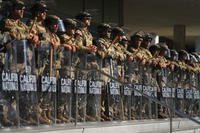National Guard officials are gearing up for what they anticipate will be a hectic year mobilizing troops for disaster responses. Right now, more than 8,000 service members are deployed supporting domestic missions within the United States as storms and wildfires become more powerful and frequent due to climate change.
The bulk of those thousands of soldiers are National Guardsmen, many of whom are already combating wildfires in California and Colorado and preparing for Super Typhoon Mawar, a massive storm that local officials say will be "catastrophic" and is expected to smash into Guam.
Guard officials held a press conference Tuesday in which senior officers updated the press on issues facing the force, with preparation for natural disasters taking center stage. The issue has become central to the Guard's mission.
Read Next: VA Claims Backlog Expected to Grow to 400K, Largely Due to the PACT Act
"Planning and preparing for disruptions to critical infrastructure from hostile actors or climate change is key to developing resilience in the homeland," Gen. Daniel Hokanson, the National Guard's top officer, said last year.
On Tuesday, officials said calls to the Guard for help are only growing.
"The demand for the Guard for domestic activities has increased. It's safe to say that, in the post-Katrina environment, the goal is to not be late," Brig. Gen. Jonathan Beddall, who oversees the Guard's domestic response missions, told reporters Tuesday. "The repetitions and sets become more frequent and refined so we can respond more quickly."
Hurricane Katrina in 2005 served as a moment of change for the military, and particularly the National Guard, in how troops could be utilized in noncombat emergencies. The hurricane, one of the worst natural disasters in U.S. history, claimed some 1,800 lives.
Fifteen years later, the Pentagon would be needed in another massive response: The COVID-19 pandemic effectively deployed the entire National Guard -- tasking soldiers with manning hospitals, delivering food to low-income communities, and administering COVID tests and vaccinations. The Guard would immediately transition into responding to the Jan. 6, 2021, insurrection to protect the U.S. Capitol after rioters attempted to violently keep then-President Donald Trump in power after he lost the election.
Those increased responsibilities placed on the Guard in recent years come as the force has reduced in size since the peak of the wars in Iraq and Afghanistan.
Governors saw the Guard's response to the pandemic and have subsequently been increasingly using the force to respond to protests and even missions outside the military's typical portfolio, such as filling in for a substitute teacher shortage and driving school buses.
But the underlying cause of more missions within the United States is climate change. Rising temperatures are making storms more violent and frequent and set the conditions for wildfires, both of which have ramped up in recent years and are expected to continue becoming even more frequent and disastrous through the next century.
Wildfire season is when the conditions are most ripe for out-of-control fires to spread in the wilderness and sometimes into residential areas. That season used to be about five months long, most of that being in the summer, but grew to seven months in the 1970s, starting earlier in the spring and lasting through a chunk of fall, according to the Department of Agriculture.
Likewise with hurricanes, the season for powerful ocean-based storms starts in June and extends into late November. Experts have warned that hurricanes have become more extreme and frequent over the past 40 years, a troubling trend that's only expected to ramp up.
"We have three storms coming in. We have a hurricane in the mid-Atlantic that's a strong Category 5. We have another Category 3, growing into a Category 5, crossing the Virgin Islands and [making] landfall in Puerto Rico, and we have a late season storm building in the Gulf of Mexico which can become very, very large, very quickly and cross into New Orleans," Maj. Gen. William Prendergast IV said Tuesday, referencing future hurricane models.
-- Steve Beynon can be reached at Steve.Beynon@military.com. Follow him on Twitter @StevenBeynon
Related: Soldiers Are Away from Home Now More than Ever Despite No Major Ongoing Wars













